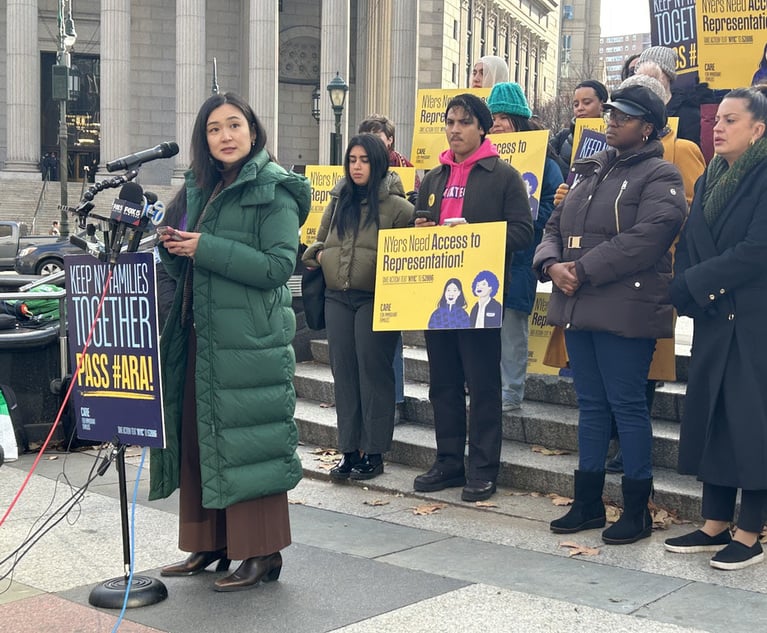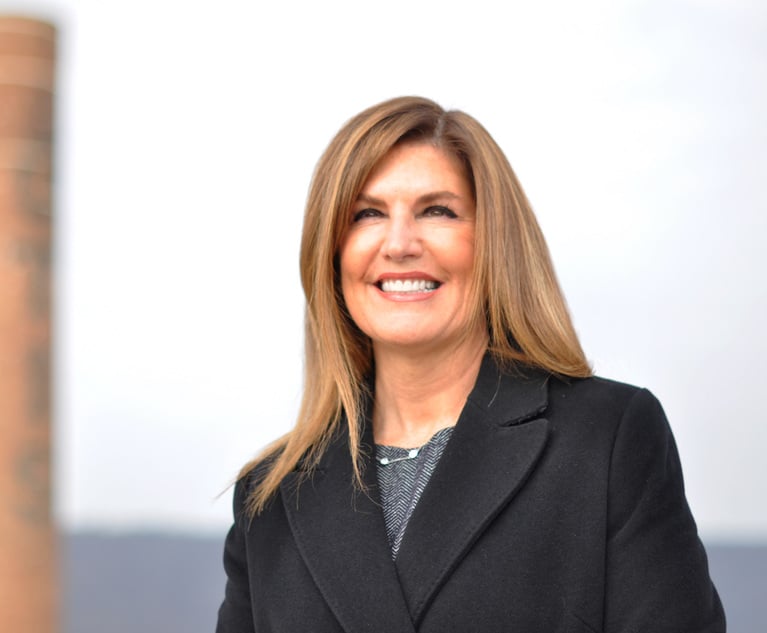 New York Chief Judge Janet DiFiore. Photo: Tim Roske
New York Chief Judge Janet DiFiore. Photo: Tim Roske DiFiore's Reorganization Plan Projected to Cost $13.1 Million Per Year, NY Court Administrators Say
The $13.1 million price tag of the restructuring plan is a net cost, meaning that it's the result of new spending balanced with money expected to be saved by the court system.
November 21, 2019 at 06:56 PM
7 minute read
A proposal to overhaul the state's current structure of trial courts, the lowest level, from Chief Judge Janet DiFiore is expected to cost the state an additional $13.1 million when fully implemented—less than a half of 1% of the judiciary's current budget.
That result was projected Tuesday by a new report from the state Office of Court Administration, which said the cost would largely come from salary increases required under the plan.
The report was released to the public the same day members of the state Legislature held the second of two hearings on DiFiore's proposal Thursday in Albany. Another hearing was held earlier this month and was the first held by lawmakers on the topic in at least two decades.
READ MORE: At Hearing on Judiciary Consolidation, AG James Urges Look at Overhaul of Town and Village Courts
Among those who testified was Chief Administrative Judge Lawrence Marks, who said lawmakers should consider the savings for litigants along with the projected cost of the plan.
"There would be savings in attorneys fees, savings in lost days at work, savings in childcare costs, savings in transportation costs," Marks said. "If cases can be resolved more quickly, if they can be resolved with fewer court appearances, litigants are going to save money."
The $13.1 million price tag of the restructuring plan is a net cost, meaning that it's the result of new spending balanced with money expected to be saved by the court system.
The cost of the plan, without considering those savings, would be an additional $18.1 million from the state, according to the report from OCA. That would be phased in over a number of years and fully implemented in 2027.
Approximately $14.3 million of that would be spent creating a similar staff structure among the state's judges and increasing the salary of nonjudicial employees. The remaining $3.8 million would be spent on raises for judges affected by the plan.
That's because the plan would merge the state's current structure of nearly a dozen trial courts into just three different sections: the state Supreme Court, the Municipal Court, and the existing town and village courts.
The state Supreme Court would be formed by eliminating many of the state's current trial courts and folding them into a unified entity. The state Court of Claims, County Courts, Family Courts and Surrogate's Courts would all be nixed under the plan.
The Municipal Court would be comprised of many of the state's more localized courts. It would be formed after a phaseout of the New York City Civil and Criminal Courts, District Courts on Long Island and the 61 city courts in upstate New York.
Those changes would come with new salaries, Marks said Thursday. Judges who sit on a County Court or Family Court are currently paid less than state Supreme Court Justices. With a new title, their salary would also be raised to match that of those on the State Supreme Court.
"Some of their staff and some court staff would have to be brought up to somewhat higher grades as well," Marks said.
At the same time, the report projected that the court system would save $5 million through a reduction in nonpersonal services, which would be a combination of smaller items saved. Think of minimal items like furniture or pens, for example, that wouldn't be needed.
Savings would not come from cutting staff, Marks said. The proposal, as it's currently written, would not remove, or consolidate, any positions currently within the court system. They're already down about 1,600 employees compared to a decade ago, Marks said.
"We're not attriting out any more employees these days. We can't afford to do that," Marks said. "The court system struggles enough with limited personnel, and we can't afford any more limited personnel."
Marks said the court system didn't have the capability to adequately place a dollar amount on how much litigants in New York would save from the plan. They did, however, calculate that litigants would spend 4.5 million fewer hours in court every year.
DiFiore's proposal has its opponents, some of which testified at Thursday's hearing.
Among them was Justice Deborah Karalunas, a judge of the state Supreme Court, Commercial Division in Onondaga County. She was critical of a section of the proposal that would empower the state to assign judges to different courts and areas of law as they see fit.
That part of the proposal is intended to allow OCA to shift judges where they're needed most. If there's a particular demand in one area, for example, OCA could ask a judge to take on some of that work, assuming they're not as needed where they're already assigned.
Karalunas, a past president of the Association of Supreme Court Justices, argued that judges should remain where they're either elected or selected to serve, rather than moving where they're told by the state.
"New York state judges are not OCA resources," Karalunas said. "We are not OCA employees."
Justice David Guy from the Surrogate's Court in Broome County also testified in opposition to the plan. He's the current president of the Surrogates' Association of the State of New York.
Guy also took the position that judges in New York should serve where they're elected, particularly when it comes to specialized proceedings like those in Surrogate's Court. Those judges often tailor proceedings to members of their community, Guy said, which may be lost if other judges are allowed to handle those cases.
"We have looked at this proposal through the lens of its stated purpose, which is to improve the delivery of justice to the citizens of New York, and in our view, as drafted, it does not fulfill that goal," Guy said.
The first hearing on the proposal earlier this month focused largely on how the plan would impact judicial diversity. Some argued that by consolidating many of the state's trial courts into a unified state Supreme Court, the share of judges of color would be even smaller.
Associate Justice Shirley Troutman, currently one of only two judges of color serving on an appellate court in upstate New York, said that, in her view, the plan would bolster efforts to increase diversity on the bench in New York.
"Something has to be done. The question is what," Troutman said. "I am here because I wholeheartedly believe the current proposal of the Chief Judge to restructure the court system will enhance diversity."
Lawmakers are expected to consider whether to move forward with the plan during next year's legislative session, which begins in January.
READ MORE:
This content has been archived. It is available through our partners, LexisNexis® and Bloomberg Law.
To view this content, please continue to their sites.
Not a Lexis Subscriber?
Subscribe Now
Not a Bloomberg Law Subscriber?
Subscribe Now
NOT FOR REPRINT
© 2024 ALM Global, LLC, All Rights Reserved. Request academic re-use from www.copyright.com. All other uses, submit a request to [email protected]. For more information visit Asset & Logo Licensing.
You Might Like
View All
Court System Names New Administrative Judges for New York City Courts in Leadership Shakeup
3 minute read

Retired Judge Susan Cacace Elected Westchester DA in Win for Democrats

In Eric Adams Case and Other Corruption Matters, Prosecutors Seem Bent on Pushing Boundaries of Their Already Awesome Power
5 minute readTrending Stories
- 1Call for Nominations: Elite Trial Lawyers 2025
- 2Senate Judiciary Dems Release Report on Supreme Court Ethics
- 3Senate Confirms Last 2 of Biden's California Judicial Nominees
- 4Morrison & Foerster Doles Out Year-End and Special Bonuses, Raises Base Compensation for Associates
- 5Tom Girardi to Surrender to Federal Authorities on Jan. 7
Who Got The Work
Michael G. Bongiorno, Andrew Scott Dulberg and Elizabeth E. Driscoll from Wilmer Cutler Pickering Hale and Dorr have stepped in to represent Symbotic Inc., an A.I.-enabled technology platform that focuses on increasing supply chain efficiency, and other defendants in a pending shareholder derivative lawsuit. The case, filed Oct. 2 in Massachusetts District Court by the Brown Law Firm on behalf of Stephen Austen, accuses certain officers and directors of misleading investors in regard to Symbotic's potential for margin growth by failing to disclose that the company was not equipped to timely deploy its systems or manage expenses through project delays. The case, assigned to U.S. District Judge Nathaniel M. Gorton, is 1:24-cv-12522, Austen v. Cohen et al.
Who Got The Work
Edmund Polubinski and Marie Killmond of Davis Polk & Wardwell have entered appearances for data platform software development company MongoDB and other defendants in a pending shareholder derivative lawsuit. The action, filed Oct. 7 in New York Southern District Court by the Brown Law Firm, accuses the company's directors and/or officers of falsely expressing confidence in the company’s restructuring of its sales incentive plan and downplaying the severity of decreases in its upfront commitments. The case is 1:24-cv-07594, Roy v. Ittycheria et al.
Who Got The Work
Amy O. Bruchs and Kurt F. Ellison of Michael Best & Friedrich have entered appearances for Epic Systems Corp. in a pending employment discrimination lawsuit. The suit was filed Sept. 7 in Wisconsin Western District Court by Levine Eisberner LLC and Siri & Glimstad on behalf of a project manager who claims that he was wrongfully terminated after applying for a religious exemption to the defendant's COVID-19 vaccine mandate. The case, assigned to U.S. Magistrate Judge Anita Marie Boor, is 3:24-cv-00630, Secker, Nathan v. Epic Systems Corporation.
Who Got The Work
David X. Sullivan, Thomas J. Finn and Gregory A. Hall from McCarter & English have entered appearances for Sunrun Installation Services in a pending civil rights lawsuit. The complaint was filed Sept. 4 in Connecticut District Court by attorney Robert M. Berke on behalf of former employee George Edward Steins, who was arrested and charged with employing an unregistered home improvement salesperson. The complaint alleges that had Sunrun informed the Connecticut Department of Consumer Protection that the plaintiff's employment had ended in 2017 and that he no longer held Sunrun's home improvement contractor license, he would not have been hit with charges, which were dismissed in May 2024. The case, assigned to U.S. District Judge Jeffrey A. Meyer, is 3:24-cv-01423, Steins v. Sunrun, Inc. et al.
Who Got The Work
Greenberg Traurig shareholder Joshua L. Raskin has entered an appearance for boohoo.com UK Ltd. in a pending patent infringement lawsuit. The suit, filed Sept. 3 in Texas Eastern District Court by Rozier Hardt McDonough on behalf of Alto Dynamics, asserts five patents related to an online shopping platform. The case, assigned to U.S. District Judge Rodney Gilstrap, is 2:24-cv-00719, Alto Dynamics, LLC v. boohoo.com UK Limited.






